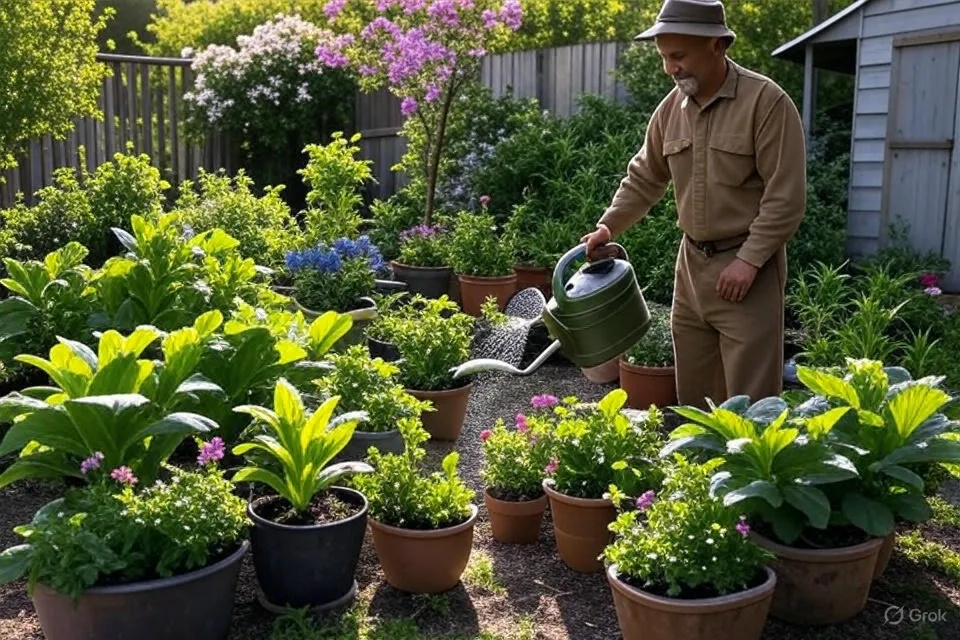Watering Wisdom: Best Practices for Container Garden Maintenance
Watering is one of the most crucial aspects of maintaining a container garden. The health of your plants depends on regular and appropriate watering procedures because the roots of plants in wholesale containers have restricted access to nutrients and water. Without a well-established watering routine, your container garden can quickly face issues like root rot, dehydration, or nutrient deficiencies. Here’s a comprehensive guide to mastering the art of watering and ensuring your plants flourish in their containers.
Understand Your Plants’ Watering Needs
Each plant has its water requirements, and understanding those needs is crucial to maintaining a healthy container garden. For example, succulents and cacti have adapted to arid environments and require very little water to thrive. Root rot, which is frequently lethal, can result from overwatering these plants. On the other hand, vegetables and tropical plants, such as tomatoes, peppers, and caladiums, need consistent moisture to grow and produce fruit. You can prevent both underwatering and overwatering by being aware of your plants’ water requirements.
It’s essential to research the specific watering needs of your container plants. For plants that prefer dry conditions, like lavender and rosemary, you can let the soil dry out completely between waterings. Conversely, plants like ferns, lettuce, and beans require consistently moist soil. By choosing plants suited to your watering schedule, you can avoid frustration and unnecessary complications.
Check the Soil Moisture
Always check the soil’s moisture content in your container before watering. The most common mistake people make is watering their plants on a fixed schedule rather than checking the soil. In warm weather, you may need to water daily, while in cooler months, watering may only be necessary once a week. The best way to check the soil’s moisture is by inserting your finger into the soil up to your first knuckle. It’s time to water if the soil feels dry at this depth. If it still feels moist, wait for another day before testing again.
For larger containers, a moisture meter is a valuable tool that can provide a more accurate reading of the soil’s moisture levels. These meters are simple to use and can help you prevent both overwatering and underwatering, ensuring your plants remain hydrated and healthy.
Watering Thoroughly
One of the most important techniques for watering container plants is ensuring that water reaches the entire root system. Unlike ground-based plants that can spread their roots far and wide to access water, plants in wholesale containers have a limited amount of soil and need consistent hydration. Watering should be done thoroughly, which means that water should be poured until it starts to run off the bottom of the container.
This method ensures that the water penetrates deep into the root zone, allowing all parts of the plant to access it. It also helps to prevent the formation of dry spots in the soil, which can cause uneven growth. It’s essential to ensure that the container has proper drainage holes to allow the water to escape, preventing the soil from becoming waterlogged.
Watering Frequency
The size of the container, the kind of plants, the season, and the weather all affect how often you need to water them. During the summer months, when temperatures rise, you may need to water your plants daily or even twice a day, especially if the container is small. Larger containers tend to hold moisture for longer, so you may not need to water them as frequently. The key is to monitor the moisture level regularly to ensure your plants don’t dry out.
In the winter months, watering needs generally decrease, but you still need to check the soil periodically. Overwatering during the winter can be just as harmful as underwatering during the summer, so be cautious and adjust your watering schedule according to the weather conditions.
Watering Techniques for Efficiency
If you’re looking to optimize your watering methods, consider using self-watering containers or a drip irrigation system. By having a reservoir at the bottom that gradually releases water to the roots as needed, self-watering containers are made to keep the soil continuously moist. This method helps reduce the risk of overwatering and ensures that the plants get a steady supply of water throughout the day.
Another great option for container gardens is drip irrigation. In order to reduce water waste and guarantee that water gets to the right place, these systems deliver water straight to the plant’s base. Additionally, drip irrigation keeps the soil’s moisture content consistent, which is advantageous for larger container gardens in particular.
Watering During Extreme Conditions
During periods of extreme heat, your container garden may need extra attention. On particularly hot days, plants in containers can dry out very quickly, even within a few hours. To reduce water evaporation brought on by the sun’s heat, think about watering in the early morning or late evening. Water may evaporate before it even reaches the roots of the plants if you water them during the hottest part of the day.
In windy conditions, containers may also dry out faster than usual. To help combat this, use a layer of mulch to cover the soil surface. Mulch helps retain moisture by reducing evaporation, keeping the soil hydrated for longer periods.
Conclusion
Watering is one of the most essential aspects of container garden maintenance. You can make sure that your container plants flourish by being aware of their particular requirements, checking the soil moisture frequently, and giving them plenty of water. Incorporating additional watering tools, such as self-watering containers or drip irrigation systems, can also improve efficiency and prevent common watering mistakes. A well-watered container garden is a healthy and vibrant garden that will reward you with beauty, fragrance, and a bountiful harvest.












